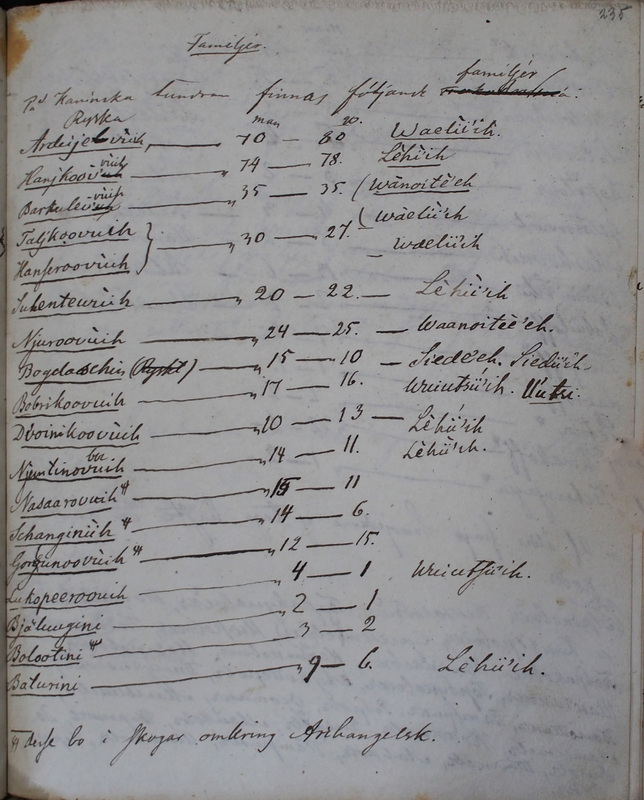Ethnographiska, historiska och statistiska anmärkningar. 235
Title
Ethnographiska, historiska och statistiska anmärkningar. 235
Description
Familjer
Families
Families
| På
Kaninska tundran
finnas följande familjerOn [page 9], Castrén listed the Nenets families in the Pustozersk volostʹʹ, noting that the Kanin tundra no longer belonged to the area. This list thus supplements the one on page 9. Interestingly, it also gives both Russian and Tundra Nenets variants for most names.
The following families live in the Kanin tundra |
|||
|
Ryska |
man |
qv[innor] |
[Samojediska] |
|
Ardeijevùih
Ardeev - Вэʹʹли. According to Chomič, Ardeev was typical of Nenets living west of Pustozersk. Similarly, she links Ardeev to Вэли, “one of the small-numbered families of European Forest Nenets” (Chomič 1976: 102–103). See also [Валей] For the European Forest Nenets, see [Archangelsk].
|
70 |
80 |
Waelìih |
|
Hanjkoou-vùih
Ханьков – Лэхэ. Ханьков possibly refers to Канюков. Лэхэ is one of the biggest families of the European Nenets. (Chomič 1976: 103–104)
|
74 |
78 |
Lèhìih |
|
Barkuleu-vùih
Ru Barakulev, TN Паркулëв, is also mentioned by Chomič as a Western surname. Ru Vanjuta, Vanoijta, TN Ванойта, fe. Ванойʹ, Ванойтиʹ or Ванюта represents one of the six main branches of the European Nenets families. It has also been suggested to represent one of the exogamic groups of the Nenets, the other being Харючи. (Chomič 1976: 102–103; Dolgich 1970: 9–14; Tereščenko 2003: 41–42)
|
35 |
35 |
Wanoitè'eh |
|
Taljkoovuih
Talʹkov – Вэʹʹли (Chomič 1976: 108).
|
30 |
27 |
Waèlìi'ih |
|
Hanseroovuih
Ханзеров (Хандер) – Вэʹʹли. According to Chomič (1976: 109), Ru Chanzerov replaced the surname Хандер. She links the family to Вануйта.
|
Waelii'ih |
||
|
Sulentewùih
Sulentʹev – Лэхэ (Chomič 1976: 107). Лэхэ is one of the biggest families of the European Nenets. (Chomič 197: 103)
|
20 |
22 |
Lèhiì'ih |
|
Njuroovùih
Njurov – Вануйта. Нюров is unclear and unknown from other sources. Ru Vanujta. Also Vanjuta, Vanojta. TN Ванойта, fe. Ванойʹ, Ванойтиʹ or Ванюта represents one of the six main branches of the European Nenets families. It has also been suggested to represent one of the exogamic groups of the Nenets, the other being Харючи. (Chomič 1976: 102–103; Dolgich 1970: 9–14; Tereščenko 2003: 41–42)
|
24 |
25 |
Waanoiteè'eh |
|
Bogdaschin
(Ryskt)Bogdašin – Сядэй. Сядэй is, according to Dolgih, a subsection of the European Лэхэ. (Dolgich 1970: 9)
|
15 |
10 |
Siede'eh. Siedii'eh |
|
Bobrikoovuih
Bobrikov – Выуци. See note [Выуческой].
|
17 |
16 |
Wuiutsií'ih. U'utsi |
|
Dvoinikoovùih
Dvojnikov – Лэхэ. Лэхэ is one of the biggest families of the European Nenets. (Chomič 1976: 103)
|
10 |
13 |
Lèhií'ih |
|
Njumtinovuih
Njumtinov – Лэхэ. Лэхэ is one of the biggest families of the European Nenets. (Chomič 1976: 103)
[вы] |
14 |
11 |
Lèhiì'ih |
|
Nasaroovuih #
Nasarov
|
15 |
11 |
|
|
Schanginiìh #
Šnaʹgin
|
14 |
6 |
|
|
Gorgunoovùih #
Gorgunov
|
12 |
15 |
|
|
Lukopeerouih
Lukoperov
|
4 |
1 |
Wuiutsiiíh |
|
Bjäluugini
Belugin
|
2 |
1 |
|
|
Bolootini #
Bolotin
|
3 |
2 |
|
|
Baturini
Baturin
|
9 |
6 |
Lèhii'ih |
# Desse bo i skogar omkring
# These live in the forests around Arkhangelsk.
Archangelsk.
Before the linguistic variety of Forest Nenets, designating the speakers of not the Tundra but Forest variety of Nenets, was developed, the Nenets might have been designated as Forest (lesnye). This historical designation did not distinguish between the language varieties, but was used to differentiate between pastoralist reindeer herders and those whose subsistence was based on fishing and hunting and who used reindeer mainly for transportation. These forest Nenets lived in close contact with the Russians, which is also reflected in their surnames. (Edemskij 1930; Brjuchanov 1939; Kolyčeva 1956; Dolgich 1970: 20–24, 30–35; Lukin 2012)
# These live in the forests around Arkhangelsk.

